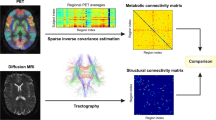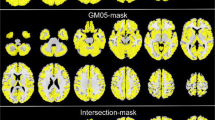Abstract
Purpose
Regionally connected areas of the resting brain can be detected by fluorodeoxyglucose-positron emission tomography (FDG-PET). Voxel-wise metabolic connectivity was examined, and normative data were established by performing interregional correlation analysis on statistical parametric mapping of FDG-PET data.
Materials and methods
Characteristics of seed volumes of interest (VOIs) as functional brain units were represented by their locations, sizes, and the independent methods of their determination. Seed brain areas were identified as population-based gyral VOIs (n = 70) or as population-based cytoarchitectonic Brodmann areas (BA; n = 28). FDG uptakes in these areas were used as independent variables in a general linear model to search for voxels correlated with average seed VOI counts. Positive correlations were searched in entire brain areas.
Results
In normal adults, one third of gyral VOIs yielded correlations that were confined to themselves, but in the others, correlated voxels extended to adjacent areas and/or contralateral homologous regions. In tens of these latter areas with extensive connectivity, correlated voxels were found across midline, and asymmetry was observed in the patterns of connectivity of left and right homologous seed VOIs. Most of the available BAs yielded correlations reaching contralateral homologous regions and/or neighboring areas. Extents of metabolic connectivity were not found to be related to seed VOI size or to the methods used to define seed VOIs.
Conclusions
These findings indicate that patterns of metabolic connectivity of functional brain units depend on their regional locations. We propose that interregional correlation analysis of FDG-PET data offers a means of examining voxel-wise regional metabolic connectivity of the resting human brain.






Similar content being viewed by others
References
Raichle ME, MacLeod AM, Snyder AZ, Powers WJ, Gusnard DA, Shulman GL. A default mode of brain function. Proc Natl Acad Sci U S A 2001;98:676–82.
Greicius MD, Krasnow B, Reiss AL, Menon V. Functional connectivity in the resting brain: a network analysis of the default mode hypothesis. Proc Natl Acad Sci U S A 2003;100:253–8.
De Luca M, Beckmann CF, De Stefano N, Matthews PM, Smith SM. fMRI resting state networks define distinct modes of long-distance interactions in the human brain. Neuroimage 2006;29:1359–67.
Rissman J, Gazzaley A, D’Esposito M. Measuring functional connectivity during distinct stages of a cognitive task. Neuroimage 2004;23:752–63.
Rombouts SA, Stam CJ, Kuijer JP, Scheltens P, Barkhof F. Identifying confounds to increase specificity during a “no task condition”. Evidence for hippocampal connectivity using fMRI. Neuroimage 2003;20:1236–45.
Lahaye PJ, Poline JB, Flandin G, Dodel S, Garnero L. Functional connectivity: studying nonlinear, delayed interactions between BOLD signals. Neuroimage 2003;20:962–74.
van de Ven VG, Formisano E, Prvulovic D, Roeder CH, Linden DE. Functional connectivity as revealed by spatial independent component analysis of fMRI measurements during rest. Hum Brain Mapp 2004;22:165–78.
Horwitz B, Braun AR. Brain network interactions in auditory, visual and linguistic processing. Brain Lang 2004;89:377–84.
Esposito F, Bertolino A, Scarabino T, Latorre V, Blasi G, Popolizio T, et al. Independent component model of the default-mode brain function: Assessing the impact of active thinking. Brain Res Bull 2006;70:263–9.
Fransson P. How default is the default mode of brain function? Further evidence from intrinsic BOLD signal fluctuations. Neuropsychologia 2006;44:2836–45.
Horwitz B. The elusive concept of brain connectivity. Neuroimage 2003;19:466–70.
Lee L, Harrison LM, Mechelli A. A report of the functional connectivity workshop, Dusseldorf 2002. Neuroimage 2003;19:457–65.
Horwitz B, Duara R, Rapoport SI. Age differences in intercorrelations between regional cerebral metabolic rates for glucose. Ann Neurol 1986;19:60–7.
Friston KJ, Rotshtein P, Geng JJ, Sterzer P, Henson RN. A critique of functional localisers. Neuroimage 2006;30:1077–87.
Penny WD, Stephan KE, Mechelli A, Friston KJ. Modeling functional integration: a comparison of structural equation and dynamic causal models. Neuroimage 2004;23(Suppl 1):S264–2S74.
Saxe R, Brett M, Kanwisher N. Divide and conquer: a defense of functional localizers. Neuroimage 2006;30:1088–96.
Lee JS, Lee DS. Analysis of functional brain images using population-based probabilistic atlas. Curr Med Imag Rev 2005;1:81–7.
Kim JJ, Crespo-Facorro B, Andreasen NC, O’Leary DS, Zhang B, Harris G, et al. An MRI-based parcellation method for the temporal lobe. Neuroimage 2000;11:271–88.
Amunts K, Zilles K. Advances in cytoarchitectonic mapping of the human cerebral cortex. Neuroimaging Clin N Am 2001;11:151–69.
Lee JS, Lee DS, Kim YK, Kim JS, Lee JM, Koo BB, et al. Quantification of brain images using Korean standard templates and structural and cytoarchitectonic probabilistic maps. J Korean Nucl Med 2004;38:241–52.
Waites AB, Briellmann RS, Saling MM, Abbott DF, Jackson GD. Functional connectivity networks are disrupted in left temporal lobe epilepsy. Ann Neurol 2006;59:335–43.
Amunts K, Malikovic A, Mohlberg H, Schormann T, Zilles K. Brodmann’s areas 17 and 18 brought into stereotaxic space-where and how variable. Neuroimage 2000;11:66–4.
Morosan P, Rademacher J, Schleicher A, Amunts K, Schormann T, Zilles K. Human primary auditory cortex: cytoarchitectonic subdivisions and mapping into a spatial reference system. Neuroimage 2001;13:684–701.
Amunts K, Schleicher A, Burgel U, Mohlberg H, Uylings HB, Zilles K. Broca’s region revisited: cytoarchitecture and intersubject variability. J Comp Neurol 1999;412:319–41.
Kang E, Lee DS, Lee JS, Kang H, Hwang CH, Oh SH, et al. Developmental hemispheric asymmetry of interregional metabolic correlation of the auditory cortex in deaf subjects. Neuroimage 2003;19:777–83.
Vogt BA, Vogt L, Laureys S. Cytology and functionally correlated circuits of human posterior cingulate areas. Neuroimage 2006;29:452–66.
Horwitz B, Duara R, Rapoport SI. Intercorrelations of glucose metabolic rates between brain regions: application to healthy males in a state of reduced sensory input. J Cereb Blood Flow Metab 1984;4:484–99.
Horwitz B, Rumsey JM, Grady CL, Rapoport SI. The cerebral metabolic landscape in autism. Intercorrelations of regional glucose utilization. Arch Neurol 1988;45:749–55.
Horwitz B, Schapiro MB, Grady CL, Rapoport SI. Cerebral metabolic pattern in young adult Down’s syndrome subjects: altered intercorrelations between regional rates of glucose utilization. J Ment Defic Res 1990;34:237–52.
Horwitz B, Swedo SE, Grady CL, Pietrini P, Schapiro MB, Rapoport JL, et al. Cerebral metabolic pattern in obsessive-compulsive disorder: altered intercorrelations between regional rates of glucose utilization. Psychiatry Res 1991;40:221–37.
Lee JS, Lee DS, Kim J, Kim YK, Kang E, Kang H, et al. Development of Korean standard brain templates. J Korean Med Sci 2005;20:483–8.
Johansen-Berg H, Behrens TE, Robson MD, Drobnjak I, Rushworth MF, Brady JM, et al. Changes in connectivity profiles define functionally distinct regions in human medial frontal cortex. Proc Natl Acad Sci USA 2004;101:13335–40.
Schmahmann JD, Pandya DN. Fiber pathways of the brain. Oxford University Press: New York; 2006.
Shulman RG, Rothman DL. Brain energetics and neuronal activity. Wes Sussex, England: Wiley and Sons Ltd; 2004.
Hertz L, Zielke HR. Astrocytic control of glutamatergic activity: astrocytes as stars of the show. Trends Neurosci 2004;27:735–43.
Gruetter R, Adriany G, Choi IY, Henry PG, Lei H, Oz G. Localized in vivo 13C NMR spectroscopy of the brain. NMR Biomed 2003;16:313–38.
Pellerin L. How astrocytes feed hungry neurons. Mol Neurobiol 2005;32:59–2.
Hyder F, Patel AB, Gjedde A, Rothman DL, Behar KL, Shulman RG. Neuronal-glial glucose oxidation and glutamatergic–GABAergic function. J Cereb Blood Flow Metab 2006;26:865–77.
Magistretti PJ. Neuron-glia metabolic coupling and plasticity. J Exp Biol 2006;209:2304–11.
Magistretti PJ, Pellerin L. Cellular mechanisms of brain energy metabolism and their relevance to functional brain imaging. Philos Trans R Soc Lond B Biol Sci 1999;354:1155–63.
Behar KL, Rothman DL. NMR studies of the metabolism and energetics of GABA neurotransmitter pathways. In: Shulman RG, Rothman DL, editors. Brain energetics and neuronal activity. West Sussex, England: Wiley; 2004. p. 100–1.
Damoiseaux JS, Rombouts SA, Barkhof F, Scheltens P, Stam CJ, Smith SM, et al. Consistent resting-state networks across healthy subjects. Proc Natl Acad Sci U S A 2006;103:13848–53.
Geyer S, Schleicher A, Zilles K. Areas 3a, 3b, and 1 of human primary somatosensory cortex. Neuroimage 1999;10:63–3.
Grefkes C, Geyer S, Schormann T, Roland P, Zilles K. Human somatosensory area 2: observer-independent cytoarchitectonic mapping, interindividual variability, and population map. Neuroimage 2001;14:617–31.
Amunts K, Jancke L, Mohlberg H, Steinmetz H, Zilles K. Interhemispheric asymmetry of the human motor cortex related to handedness and gender. Neuropsychologia 2000;38:304–12.
Malikovic A, Amunts K, Schleicher A, Mohlberg H, Eickhoff SB, Wilms M, et al. Cytoarchitectonic analysis of the human extrastriate cortex in the region of V5/MT+: a probabilistic, stereotaxic map of area hOc5. Cereb Cortex 2007;17:562–74.
Caspers S, Geyer S, Schleicher A, Mohlberg H, Amunts K, Zilles K. The human inferior parietal cortex: cytoarchitectonic parcellation and interindividual variability. Neuroimage 2006;33:430–48.
Amunts K, Kedo O, Kindler M, Pieperhoff P, Mohlberg H, Shah NJ, et al. Cytoarchitectonic mapping of the human amygdala, hippocampal region and entorhinal cortex: intersubject variability and probability maps. Anat Embryol (Berl) 2005;210:343–52.
Acknowledgments
This study was supported by the Brain Research Center of the 21st Century Brain Frontier Project of the Korean Ministry of Science (M103KV010017-07K2201-01710), by the Korean Science and Engineering Foundation (KOSEF), and by the Korean Ministry of Science and Technology (MOST) through its National Nuclear Technology Program (#M20504070004-05A0707-00410). We deeply appreciate the efforts of Professors Zilles and Amunts for transferring their Brodmann Areas to Korean templates. This study utilized KREONET (the Korean Research Network) a Giga-bps high speed network.
Author information
Authors and Affiliations
Corresponding author
Electronic supplementary material
Below is the link to the electronic supplementary material.
Supplementary Fig. 1
Number of gyral VOIs with correlation ranging from (1) autocorrelation only to (2) correlation with contralateral homologous and adjacent/remote areas (GIF 13 KB)
Supplementary Fig. 2
Left and right Heschl’s gyri showing areas of autocorrelation only (GIF 184 KB)
Supplementary Fig. 3
Left and right Putamen showing areas correlated with themselves and contralateral homologues (GIF 192 KB)
Supplementary Fig. 4
Left and right precentral gyri showing areas correlated more distant regions even beyond midline (GIF 204 KB)
Supplementary Fig. 5
Left and right BA44 showing area with widespread correlations. Note the hemispheric asymmetry of correlated regions for left and right BA44 (GIF 195 KB)
Supplementary Fig. 6
a Areas showing interregional correlations with seed VOIs of left and right frontal or parietal lobes. b Areas showing interregional correlations with seed VOIs of left and right temporal and occipital lobes (GIF 195 KB; GIF 183 KB)
Supplementary Fig. 7
Correlation between sizes of correlated areas and seed VOI sizes. Sizes of correlated areas were measured sizes minus seed VOI sizes (GIF 7 KB)
Supplementary Table 1
Sizes of seed VOIs belonging to each lobe represented by numbers of voxels in areas with more than a 10% probability (10–100%) (DOC 65 KB)
Rights and permissions
About this article
Cite this article
Lee, D.S., Kang, H., Kim, H. et al. Metabolic connectivity by interregional correlation analysis using statistical parametric mapping (SPM) and FDG brain PET; methodological development and patterns of metabolic connectivity in adults. Eur J Nucl Med Mol Imaging 35, 1681–1691 (2008). https://doi.org/10.1007/s00259-008-0808-z
Received:
Accepted:
Published:
Issue Date:
DOI: https://doi.org/10.1007/s00259-008-0808-z




